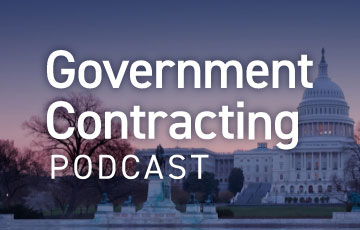Contributor:
John Ford | Senior Consultant, Government Contracting Industry Practice
For commercial companies that have never had a grant or cooperative agreement (CA), knowing what the rules of the game are can be a daunting challenge. In this article, we explain what these instruments are and give an overview of the regulations that apply, with an emphasis on Department of Energy (DoE) regulations. For purposes of this article, when we refer to a grant, we are also referring to a cooperative agreement unless stated otherwise.
Grants and CAs Defined
Grants and CAs are described in the Grants and Cooperative Agreements Act, 31 U.S.C. §6301 et. seq. Under both a grant and CA, the principal purpose of the transaction is to transfer a thing of value to a recipient to carry out a public purpose of support or stimulation authorized by a law instead of acquiring property or services for the direct benefit or use of the Government. The distinction between the two is the amount of governmental involvement in the performance of the agreement with the government having little or no involvement in the performance of a grant, but having substantial involvement in the performance of a CA.
In accordance with Federal Acquisition Regulation (FAR) 2.101, grants are not contracts subject to the FAR. Thus, there is little relationship between the FAR and a grant. The principle source of guidance concerning grants is the Office of Management and Budget’s (OMB) “Uniform Administrative Requirements, Cost Principles, and Audit Requirements for Federal Awards” found at 2 CFR 200.
This guidance is generally referred to as the “Uniform Guidance.” A little discussion on the background of the Uniform Guidance is necessary to understand its relationship to commercial companies.
Uniform Guidance
The Uniform Guidance was promulgated on December 26, 2013. Prior to that, there were separate OMB Circulars addressing grants to state and local governments, Indian tribes, institutions of higher education, nonprofit organizations and hospitals. The Uniform Guidance consolidated the guidance contained in the circulars covering state and local governments, Indian tribes, institutions of higher education, and nonprofit organizations, but did not address awards to hospitals and most notably awards to commercial organizations, although “[p]arts of it may also apply to for-profit entities in limited circumstances.”
It should be noted that the Uniform Guidance is not a regulation. Instead, it is to be used as the basis for regulations promulgated by individual agencies. Thus, individual agencies are responsible for issuing regulations that address grants issued by those agencies. For example, the Department of Energy has issued its regulations at 2 CFR 910. Specifically, 2 CFR 910.102 states:
. . . the Department of Energy adopts the Office of Management and Budget (OMB) Guidance in 2 CFR part 200, with the following additions. Thus, this part gives regulatory effect to the OMB guidance and supplements the guidance as needed for the Department.
(b) The additions include: Expanding the definition of non-Federal entity for DOE to include For-profit entities; adding back additional coverage from 10 CFR part 600 required by DOE statute; adding back coverage specific for For-Profit entities which existed in 10 CFR part 600 which still applies.
Although, the Uniform Guidance does not generally apply to for-profit (commercial) organizations, the supplemental material in the DoE regulations addresses such organizations. In this regard, DoE defines a for-profit organization as “one that distributes any profit not reinvested into the business as profit or dividends to its employees or shareholders.”
DoE Grants Vs. Contracts: Requirements
Turning to some of the requirements for DoE grants that are different from contracts, most grants are cost reimbursement grants. However, such grants do not provide for a fee except for SBIR/STTR awards. Further, most awards for research, development, demonstration and commercial applications activities require cost sharing. A cost share of at least 20% of the cost of the activity is required for research and development and a cost share of at least 50% of the cost of a demonstration or commercial application activity is generally required.
The cost principles in FAR subpart 31.2 are used to determine what costs are eligible for reimbursement, except that patent prosecution costs are generally not allowable. Like most contracts, reimbursement is to be made within 30 days after receipt of an invoice. However, the Prompt Payment Act does not apply to grants. Accordingly, if DoE makes a late payment, the recipient is not entitled to an interest penalty payment.
Audits
One of the significant differences between having a contract subject to the FAR and a grant under the DoE regulations is the requirement to have what is known as a compliance audit, i.e., an audit to determine if the auditee complied with Federal statutes, regulations, and the terms and conditions of Federal awards. A compliance audit is required annually for each award under which the recipient had expenditures of $750,000 in the recipients last fiscal year.
Interestingly, DoE does not conduct the compliance audit. Instead, the recipient is responsible for selecting the auditor that will conduct the audit. In this regard, the DoE regulations state that “[f]actors to be considered in evaluating each proposal for audit services include the responsiveness to the request for proposal, relevant experience, availability of staff with professional qualifications and technical abilities, the results of peer and external quality control reviews, and price.” Additionally, whenever possible, the recipient must make positive efforts to utilize small businesses, minority-owned firms, and women’s business enterprises, in procuring audit services. Finally, an auditor who prepares the indirect cost proposal or cost allocation plan for the recipient may not also be selected to perform the compliance audit when the indirect costs recovered by the recipient during the prior year exceeded $1 million.
Because the recipient is responsible for obtaining the compliance audit, the recipient is responsible for paying for it. However, a reasonably proportionate share of the cost will be borne by DoE.
Your Guide Foward
This is only an overview of the requirements that a recipient must meet under a DoE grant. If you need advice and assistance concerning a grant or cooperative agreement from DoE or any other agency, do not hesitate to reach out to us. Cherry Bekaert can also help satisfy the compliance audit requirement should you expend $750,000 or more during the last fiscal year.




